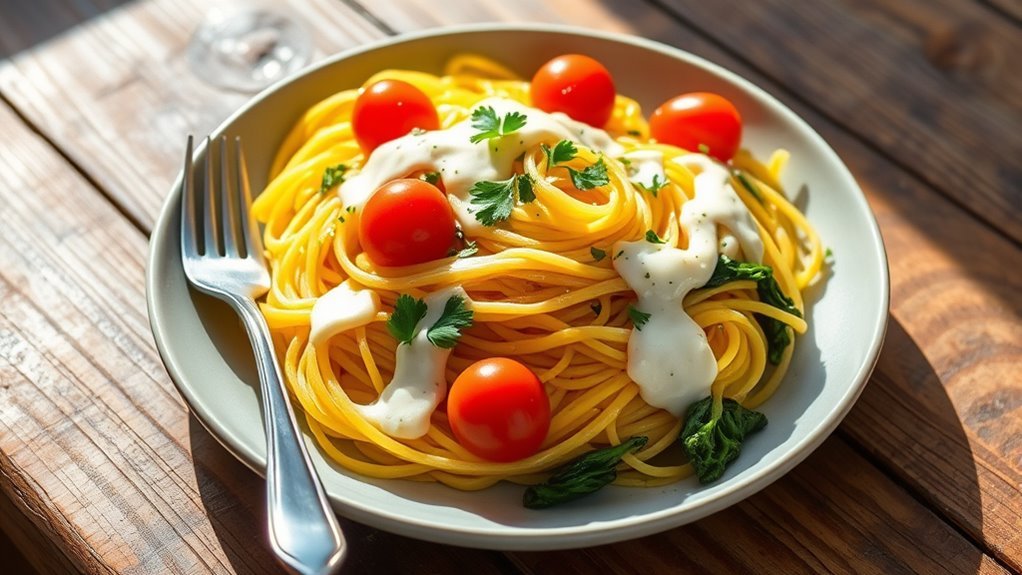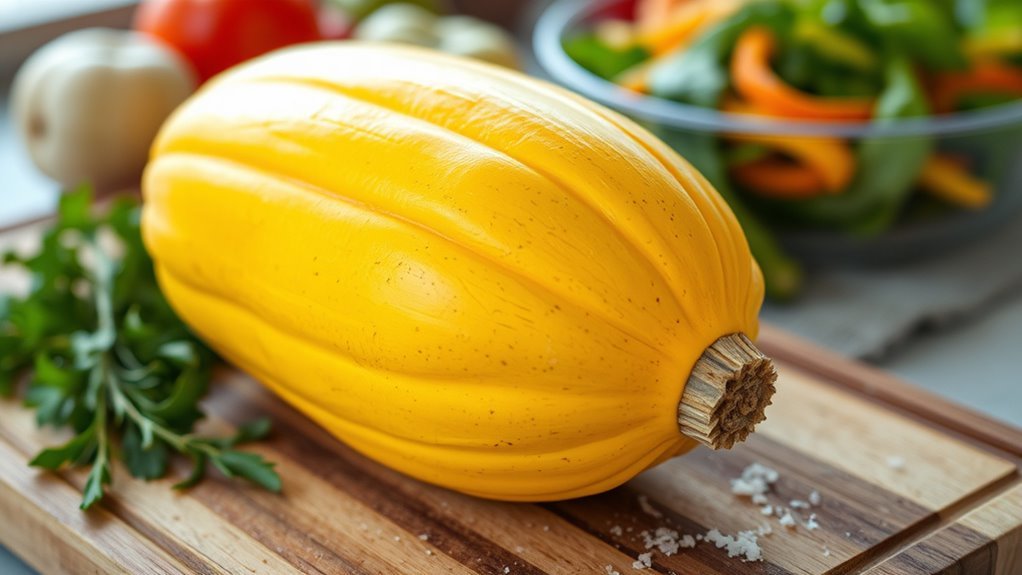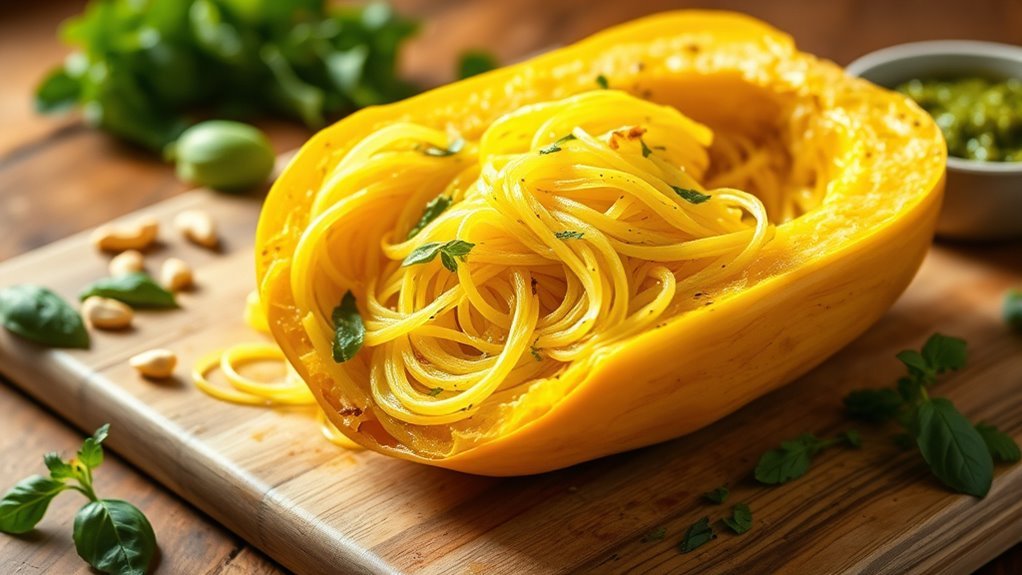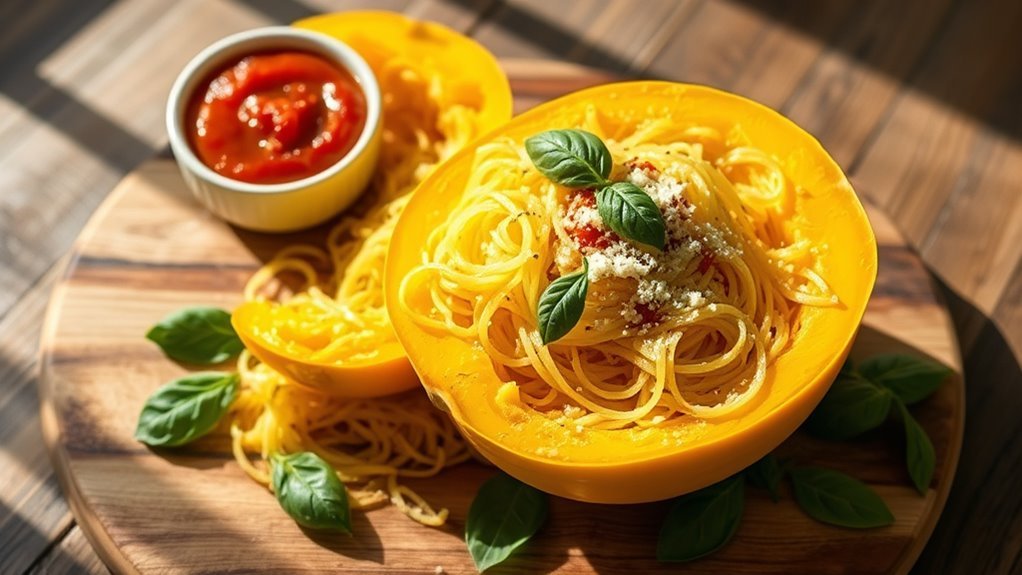Yes, you can definitely have spaghetti squash on a ketogenic diet! It’s a low-carb alternative to traditional pasta, containing about 10 grams of carbohydrates per cooked cup. With its unique texture and nutrient profile, spaghetti squash provides fiber, vitamins, and minerals, making it a great way to enhance your meals. Plus, it pairs well with various keto-friendly proteins and sauces. If you’re interested, there are plenty of delicious recipes to try out that fit seamlessly into your keto meal plan.
Understanding the Ketogenic Diet

To truly grasp the ketogenic diet, you need to understand its fundamental principles. At its core, the ketogenic diet focuses on drastically reducing carbohydrate intake while increasing fat intake. This shift forces your body into a metabolic state called ketosis, where it burns fat for fuel instead of carbohydrates. The typical macronutrient ratio is about 70-75% fat, 20-25% protein, and only 5-10% carbohydrates. By adhering to these ketogenic principles, you’ll likely experience benefits like weight loss, improved energy levels, and enhanced mental clarity. It’s crucial to choose healthy fats, such as avocados, nuts, and olive oil, to maximize your results. Embracing this lifestyle gives you the freedom to enjoy satisfying meals while transforming your health.
What Is Spaghetti Squash?

Spaghetti squash is a unique vegetable that offers a low-carb alternative to traditional pasta, making it a popular choice for those on a ketogenic diet. Packed with essential nutrients, it provides fiber, vitamins, and minerals while keeping your carb intake in check. You can prepare spaghetti squash in various ways, including roasting, steaming, or microwaving, each method bringing out its distinct flavor and texture.
Nutritional Profile Overview
A unique member of the gourd family, spaghetti squash is a versatile vegetable known for its distinctive stringy texture. This low-carb option packs impressive nutritional benefits, making it a great choice for those focused on weight loss. With around 37 calories per cup, it’s a light addition to your meal prep. Spaghetti squash is rich in dietary fiber, which supports digestive health and helps you feel full longer. It also boasts a solid vitamin content, including vitamin C and several B vitamins, while its mineral profile includes potassium and manganese. Incorporating spaghetti squash into your diet can enhance your meals and provide essential nutrients without compromising your low-carb lifestyle.
Cooking Methods Explained
Understanding what spaghetti squash is can enhance your appreciation for this unique vegetable. It’s a versatile, low-carb alternative to traditional pasta, perfect for keto dieters. Here are some popular cooking methods to try:
- Steaming Techniques: Steaming retains nutrients and moisture. You can cut the squash in half, remove the seeds, and steam it for about 15-20 minutes until tender.
- Grilling Options: Grilling adds a smoky flavor. Halve the squash, brush it with olive oil, and grill cut-side down for about 10-15 minutes.
- Baking: Baking is simple. Just place the halved squash in the oven at 400°F for 30-40 minutes, scrape out the strands, and enjoy!
Each method brings out the squash’s natural sweetness while keeping your keto goals in check.
Nutritional Profile of Spaghetti Squash

While many people might overlook spaghetti squash as a mere vegetable, its nutritional profile makes it a valuable addition to a keto diet. With its low carbohydrate content, it offers several spaghetti squash benefits, including being rich in vitamins and minerals.
Here’s a quick comparison of its nutritional components:
| Nutrient | Amount per 1 cup (cooked) |
|---|---|
| Calories | 42 |
| Carbohydrates | 10g |
| Fiber | 2.2g |
| Protein | 1g |
| Fat | 0.4g |
If you’re looking for spaghetti squash substitutes, consider zucchini or cauliflower, both of which can also fit into your low-carb lifestyle. Embrace the freedom of tasty, nutritious meals!
Carb Content Comparison: Spaghetti Squash vs. Traditional Pasta
When comparing spaghetti squash to traditional pasta, you’ll notice a significant difference in carbohydrate content. Spaghetti squash contains about 7 grams of carbs per cup, while traditional pasta can have around 43 grams per cup. This stark contrast makes spaghetti squash a popular choice for those following a keto diet.
Nutritional Profile Overview
Spaghetti squash offers a compelling alternative for those on a keto diet, especially when you compare its carb content to that of traditional pasta. The nutritional advantages of spaghetti squash are significant, making it a popular choice for health-conscious eaters. Here are three key spaghetti squash benefits:
- Lower Carbohydrate Content: Spaghetti squash typically has about 5-7 grams of net carbs per cup, compared to around 40 grams in traditional pasta.
- High Fiber: With about 2 grams of fiber per cup, it aids digestion and promotes satiety.
- Rich in Vitamins: Spaghetti squash provides important nutrients like vitamin C and B vitamins, enhancing overall health.
Carb Count Comparison
For anyone following a keto diet, understanding the carbohydrate content of food choices is essential. Spaghetti squash offers impressive benefits, especially when compared to traditional pasta. While a cup of cooked spaghetti squash contains about 7 grams of carbs, a similar serving of regular pasta can pack around 40 grams. This stark difference makes spaghetti squash an excellent choice for keto meal ideas, allowing you to enjoy a satisfying dish without derailing your carb limits. Furthermore, its low-calorie content helps keep your meals light yet filling. By incorporating spaghetti squash into your diet, you’ll not only enjoy its versatility but also stay aligned with your keto goals, giving you the freedom to savor delicious meals without guilt.
How Spaghetti Squash Fits Into a Keto Meal Plan
Although many people think of traditional pasta as a staple in their diets, incorporating spaghetti squash into a keto meal plan can be a delicious and satisfying alternative. This versatile vegetable allows you to enjoy a low-carb option while still feeling full. Here’s how you can make spaghetti squash fit into your keto meal prepping:
- Choose Your Spaghetti Squash Varieties: Different types offer varying flavors; try yellow or white for a mild taste.
- Create Keto-Friendly Sauces: Pair it with low-carb sauces like pesto or marinara to enhance the flavor without added sugars.
- Add Protein: Combine the squash with protein sources like grilled chicken or shrimp for a well-rounded meal.
Health Benefits of Spaghetti Squash
While you might be seeking low-carb options, spaghetti squash offers a range of health benefits that make it an excellent addition to your diet. This vegetable is known for its impressive nutrient density, packing essential vitamins like A, C, and B vitamins, along with minerals such as potassium and magnesium. These nutrients support overall health while keeping your carb intake low.
Additionally, spaghetti squash is high in fiber, which is essential for digestive health. Fiber helps regulate bowel movements and can prevent constipation, promoting a healthy gut. Incorporating spaghetti squash into your meals not only diversifies your plate but also boosts your nutritional intake, allowing you to enjoy the freedom of a satisfying, health-conscious lifestyle.
Cooking Methods for Spaghetti Squash
When it comes to cooking spaghetti squash, you’ve got a couple of effective methods to choose from. Roasting brings out its natural sweetness and creates a delightful texture, while microwaving offers a quicker option without sacrificing too much flavor. Understanding these techniques can help you enjoy this versatile vegetable in no time.
Roasting Techniques Explained
Roasting spaghetti squash is one of the most effective methods for transforming this versatile vegetable into a delightful, low-carb dish. To master roasting techniques, keep these roasting tips in mind:
- Preheat your oven: Aim for 400°F (200°C) to guarantee even cooking.
- Cut the squash properly: Slice it in half lengthwise and scoop out the seeds for an ideal roast.
- Season generously: Drizzle with olive oil, sprinkle salt, and add your favorite herbs to enhance flavor.
Microwave Cooking Tips
If you’re short on time or prefer a quicker method, cooking spaghetti squash in the microwave can yield excellent results. Start by cutting the squash in half lengthwise and removing the seeds. Place the halves cut-side down in a microwave-safe dish with a bit of water. Cover it with a microwave-safe lid or plastic wrap to trap steam, which helps achieve the desired squash texture. Microwave on high for about 10 to 12 minutes, adjusting microwave timing based on the size of your squash. Check for doneness by piercing the flesh with a fork; it should easily shred into strands. This method not only saves time but also preserves nutrients, making it a smart option for your keto lifestyle.
Flavor Pairings for Spaghetti Squash on Keto
Although spaghetti squash is a versatile ingredient on a keto diet, the right flavor pairings can elevate its appeal even further. Consider these three categories to enhance your dish:
- Protein Options: Grilled chicken or shrimp adds a satisfying heft, while crumbled sausage brings a savory depth.
- Herb Enhancements: Fresh basil or rosemary can brighten flavors, while thyme offers an earthy contrast.
- Cheese Toppings: Melting mozzarella or a sprinkle of parmesan introduces richness and umami.
Don’t forget about sauce pairings like pesto or marinara for added zest. You can also include veggie additions such as spinach or bell peppers, and sprinkle in seasoning suggestions like garlic powder for extra flavor. With these combinations, your spaghetti squash can truly shine!
Tips for Measuring Portions
Measuring portions accurately is essential when following a keto diet, as it helps you manage your carb intake effectively. For spaghetti squash, understanding serving sizes is important for portion control. Start by weighing your cooked squash; a typical serving is about one cup, which contains roughly 10 grams of carbs. Use a kitchen scale for precision, and don’t hesitate to measure out your servings before adding sauces or toppings. If you’re dining out, ask for nutritional information whenever possible. Remember, staying within your carb limit allows flexibility and enjoyment in your meals. By being mindful of portion sizes, you can savor spaghetti squash while adhering to your keto lifestyle, giving you the freedom to indulge without guilt.
Delicious Keto-Friendly Spaghetti Squash Recipes
Now that you have a good grasp on portion control, it’s time to explore some delicious keto-friendly spaghetti squash recipes that can elevate your meals. Spaghetti squash is a versatile base that pairs beautifully with various keto sauces and low carb toppings. Here are three tasty ideas to inspire your meal prep:
Explore delicious keto-friendly spaghetti squash recipes that elevate your meals with versatile sauces and low carb toppings!
- Garlic Butter Shrimp: Toss roasted spaghetti squash with sautéed shrimp in garlic butter and sprinkle with parsley.
- Creamy Alfredo: Mix spaghetti squash with a rich, homemade Alfredo sauce and add grilled chicken for protein.
- Pesto Veggie Medley: Combine spaghetti squash with sautéed zucchini, bell peppers, and a dollop of high-quality pesto.
These recipes not only satisfy your cravings but also keep you aligned with your keto lifestyle!
Frequently Asked Questions
Is Spaghetti Squash Suitable for Other Low-Carb Diets?
Yes, spaghetti squash is suitable for other low-carb diets due to its low carbohydrate content and nutritional benefits. It’s rich in vitamins A and C, fiber, and antioxidants, making it a healthy choice. You can prepare it in various ways—roasting, steaming, or microwaving—to enhance its flavor and texture. This versatility allows you to enjoy it as a pasta alternative or in salads, giving you the freedom to create satisfying meals while staying on track.
Can I Eat Spaghetti Squash Raw?
You can eat spaghetti squash raw, but it’s not common. While it offers some raw benefits, like retaining its nutritional content—fiber, vitamins, and antioxidants—you might find its taste and texture a bit off-putting. Most people prefer it cooked, as it enhances the flavor and makes it easier to digest. If you’re adventurous, try slicing it thinly in salads or as a crunchy topping, but be prepared for a unique experience!
How Do I Store Leftover Spaghetti Squash?
To store leftover spaghetti squash, place it in an airtight container in the fridge for up to a week. For best results, make sure it’s cooled before sealing. When you’re ready to enjoy it again, you can reheat it in the microwave or on the stovetop with a splash of olive oil. If you want to maintain its texture, avoid high heat and reheating for too long—just warm it through!
Is Spaghetti Squash Gluten-Free?
Yes, spaghetti squash is gluten-free! This makes it an excellent alternative for those avoiding gluten. Not only does it provide nutritional benefits like vitamins A and C, but it’s also low in carbs. You can enjoy it baked or microwaved, making it versatile for various dishes. By incorporating spaghetti squash into your meals, you’re not just embracing a healthier option; you’re also enjoying a delicious, guilt-free experience that supports your dietary freedom.
Can I Substitute Spaghetti Squash in Any Pasta Dish?
Yes, you can definitely substitute spaghetti squash in pasta dishes! It’s a versatile option that works well in various spaghetti squash recipes. When you spiralize or roast spaghetti squash, it mimics the texture of traditional pasta, making it an excellent pasta alternative. You can use it in dishes like spaghetti with marinara or even in stir-fries. This way, you enjoy your favorite meals while keeping things low-carb and healthy.


